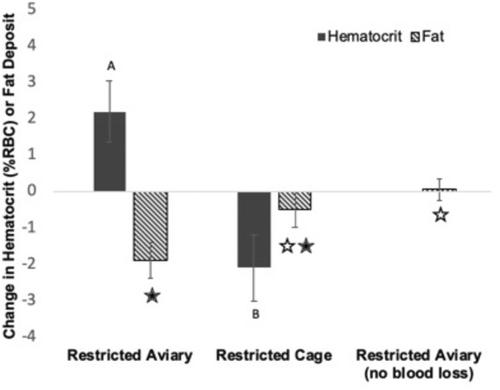当前位置:
X-MOL 学术
›
J. Exp. Zool. Part A
›
论文详情
Our official English website, www.x-mol.net, welcomes your
feedback! (Note: you will need to create a separate account there.)
Recovery of hematocrit and fat deposits varies by cage size in food‐restricted captive red crossbills (Loxia curvirostra)
Journal of Experimental Zoology Part A ( IF 1.9 ) Pub Date : 2020-10-07 , DOI: 10.1002/jez.2417 Dawson C. Bradley 1 , Megan Wurtz 1 , Jamie M. Cornelius 2
Journal of Experimental Zoology Part A ( IF 1.9 ) Pub Date : 2020-10-07 , DOI: 10.1002/jez.2417 Dawson C. Bradley 1 , Megan Wurtz 1 , Jamie M. Cornelius 2
Affiliation

|
Hematocrit—or the percent volume of red blood cells in whole blood—is thought to fluctuate adaptively in response to changing oxygen demands that occur during different life activities and in different environments. Because red blood cells are made from materials that can be limiting, however, it is thought that hematocrit may also reflect general body condition and access to resources. We tested the effect of hydration state, resource restriction (i.e., time available to forage), and activity (i.e., different cage sizes) on hematocrit in captive red crossbills (Loxia curvirostra). We found no evidence that a mild dehydration protocol impacts hematocrit and only weak support that mild food restriction impacts hematocrit. Food restriction did, however, reduce fat deposits and fat loss was more significant in birds that were also sampled for hematocrit. Furthermore, food‐restricted birds housed in flight aviaries recovered hematocrit but not fat stores following repeated blood sampling, whereas birds housed in small cages lost additional hematocrit but mitigated fat loss following successive bleeds. Together these results suggest that different flight demands may determine response to blood loss during food restriction, potentially revealing a trade‐off between fat storage and red blood cell development. Our results also demonstrate the need for scientists to carefully record hematocrit data and the time course across which multiple tubes of blood are collected to avoid confounding real patterns with variation generated by sampling protocol.
中文翻译:

受食物限制的圈养红嘴b(Loxia curvirostra)中血细胞比容和脂肪沉积的恢复因笼子大小而异
血细胞比容(或全血中红细胞的百分比)被认为会适应不同生活活动和不同环境中发生的氧气需求变化而自适应地波动。但是,由于红血球是由可能具有限制作用的材料制成的,因此人们认为血细胞比容还可能反映出总体身体状况和对资源的获取。我们测试了水合状态,资源限制(例如,可用于觅食的时间)和活性(即,不同的笼子大小)对圈养红色斜纹小鸟(Loxia curvirostra)中血细胞比容的影响。)。我们没有发现轻度脱水方案会影响血细胞比容的证据,只有证据表明轻度食物限制会影响血细胞比容。然而,食物限制的确减少了脂肪的沉积,并且在还进行了血细胞比容采样的禽类中,脂肪的损失更为明显。此外,经过多次采血后,在飞行鸟舍中受食物限制的鸟类恢复了血细胞比容,但没有恢复脂肪储存,而在小笼子中饲养的鸟类损失了更多的血细胞比容,但减轻了连续出血后的脂肪损失。这些结果共同表明,不同的飞行需求可能决定食物限制期间对失血的反应,这可能揭示了脂肪存储与红细胞发育之间的权衡。
更新日期:2020-10-30
中文翻译:

受食物限制的圈养红嘴b(Loxia curvirostra)中血细胞比容和脂肪沉积的恢复因笼子大小而异
血细胞比容(或全血中红细胞的百分比)被认为会适应不同生活活动和不同环境中发生的氧气需求变化而自适应地波动。但是,由于红血球是由可能具有限制作用的材料制成的,因此人们认为血细胞比容还可能反映出总体身体状况和对资源的获取。我们测试了水合状态,资源限制(例如,可用于觅食的时间)和活性(即,不同的笼子大小)对圈养红色斜纹小鸟(Loxia curvirostra)中血细胞比容的影响。)。我们没有发现轻度脱水方案会影响血细胞比容的证据,只有证据表明轻度食物限制会影响血细胞比容。然而,食物限制的确减少了脂肪的沉积,并且在还进行了血细胞比容采样的禽类中,脂肪的损失更为明显。此外,经过多次采血后,在飞行鸟舍中受食物限制的鸟类恢复了血细胞比容,但没有恢复脂肪储存,而在小笼子中饲养的鸟类损失了更多的血细胞比容,但减轻了连续出血后的脂肪损失。这些结果共同表明,不同的飞行需求可能决定食物限制期间对失血的反应,这可能揭示了脂肪存储与红细胞发育之间的权衡。











































 京公网安备 11010802027423号
京公网安备 11010802027423号